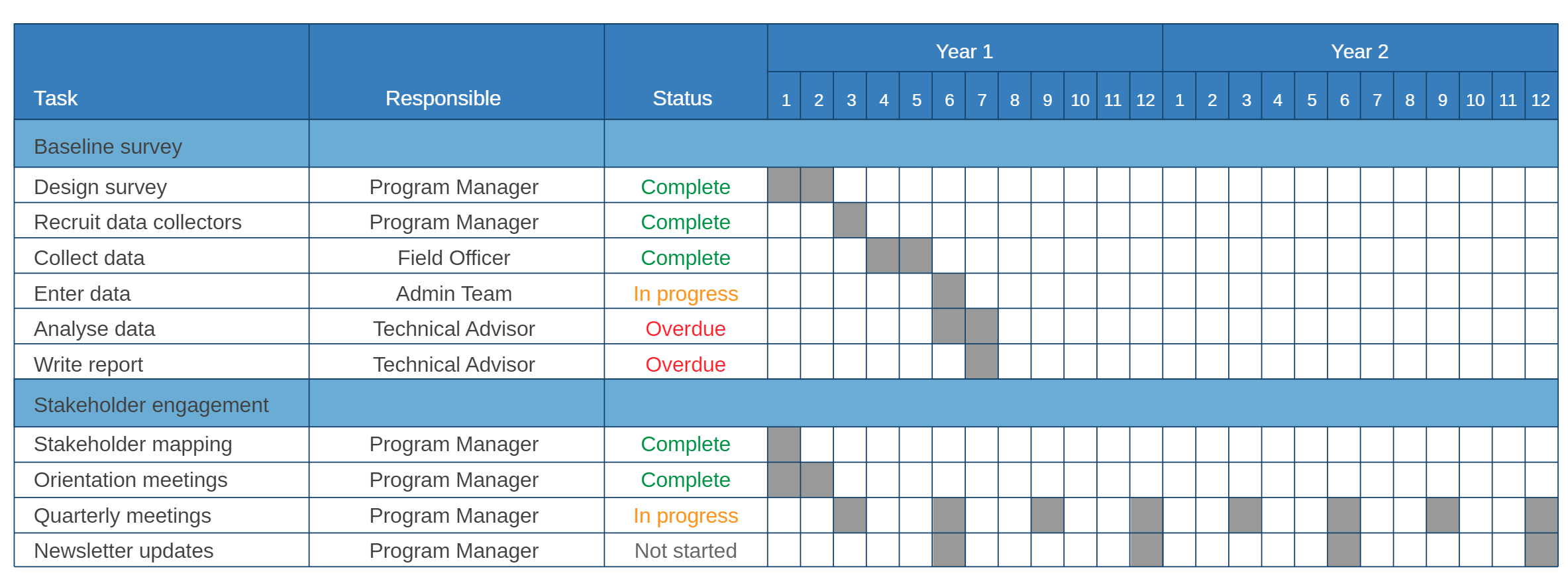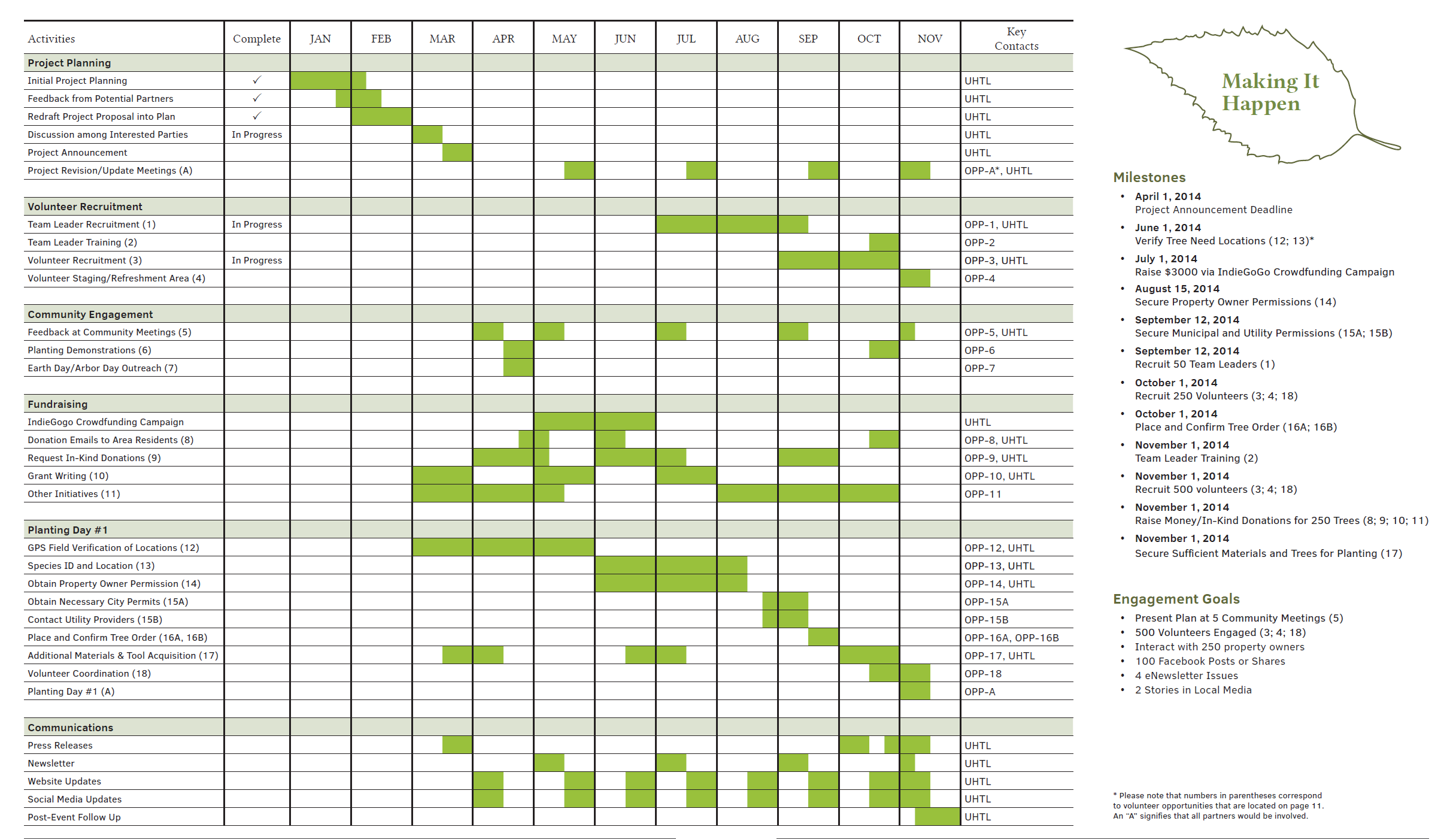Work Plans
A work plan is a tool that improves the effectiveness of project implementation by assigning tasks, articulating responsibilities, managing workflows, and plan important role in tracking progress, milestones, and deadlines. In short, work plans help projects stay organized and efficient.
Without clear tasks and deadlines, a collaborative team can quickly resort to blindly working on tasks without purpose. When tasks and milestones are defined, individual team members are more easily able to complete tasks that bring the project toward successful implementation.
When it comes to project management, this adage holds true in developing work plans. The longer it takes to finish a project, the more it costs in labor and materials.
Once tasks, deadlines, and responsibilities are assigned, project managers are more able to track implementation progress. At each milestone, progress and challenges to implementation should be reported. This can help the project team develop an action plan to address and overcome problems before they set the project off course.
Planning Projects with Gantt Charts
Use these videos to learn more about using Gantt Charts for building work plans.
Planning Projects with Gantt Charts
Make a Gantt Chart in Excel
Using Stakeholder Analysis to define roles and gain buy-in
Strategies & Tips for Success
Make your work planning efforts more effective by keeping these strategies and tips in mind.
Effective work plans allow project managers to oversee the big picture and empowers team members to lead on individual tasks.
A work plan usually covers a period of six to 12 months, but it can be adjusted if the project is shorter.
Clearly articulate required steps by setting demonstrable objectives and noting tangible deliverables.
Schedule every task and deliverable using milestones and deadlines.
After tasks, deliverables, and deadlines are set, individuals and small teams should be assigned to be responsible for each.
Unexpected things will happen and you should build extra time/space into your schedule to prevent falling behind.
Work plans can be easily created with Excel or Google sheets, and often use Gantt Charts to visualize the timeline.
An effective work plan will also have buy-in from key stakeholders, so make sure to get feedback from all individuals, organizations, and institutions involved in the project.
Each team member should be able to create a checklist of tasks that they are responsible for.
Practical Activities & Learning
1) Review the “Logic Model” you created in the Logic Models & Theory of Change Module and the “Goals & Metrics Table” you created in the previous module (Aligning Goals & Metrics).
2) Create a table (or spreadsheet) listing the Activities from the Logic Model in the first column. Name this column "Activities & Tasks).
3) Under each Activity, list the key tasks that must be completed to produce the outputs listed in the “Outputs” section of the logic model and meet the targets included in the Goals & Metrics Table.
4) Add 4-12 “Implementation” columns, depending on your planned reporting/meeting frequency (weekly, monthly, quarterly, etc)
5) Create the “Gantt Chart” feature of the work plan by highlighting (or filling with color) each cell in the Implementation columns that corresponds to the timeline and milestones associated with each task.
6) Add another column labeled “Milestones” and list the key milestone (or deliverable submission deadlines) associated with each task. There should only be one milestone or deadline per task.
7) Add another column labeled “Deliverables” and list the tangible deliverable associated with each task. Each task should have a maximum of one deliverable.
8) Add two more columns labeled “Responsible” and “Support.” Add a primary person/individual responsible for each task. You can add agencies, organizations, and other individuals as support for each task.
9) Add one final column called “Status.” As the project is implemented, you can use this column to communicate the status of each task as “In Progress,” or “Complete.”
10) Share your draft work plan with everyone listed in the plan, as well as other key stakeholders that need to be ‘bought-in’ to the plan.
In the Field
As a neighborhood consultant, you can submit up to 3 work plans for the programs, processes, and services you’re working on. Notes and outputs should be summarized and shared to enhance our learning.
Work Plan Field Journal Worksheets available on request from aaron[at]akroadvice.com





